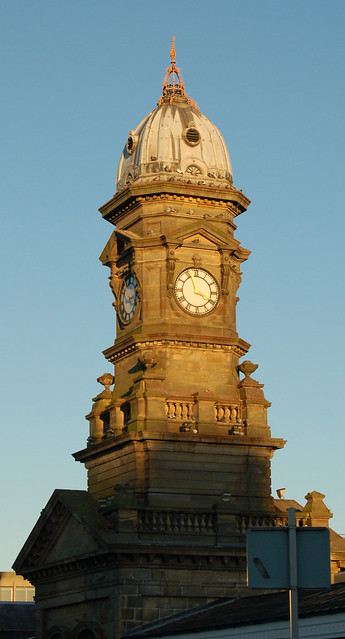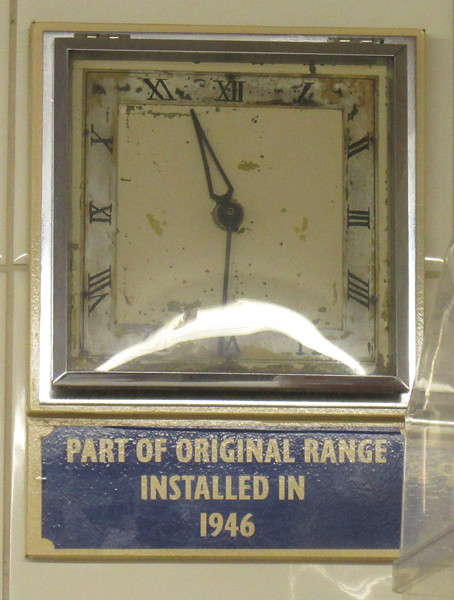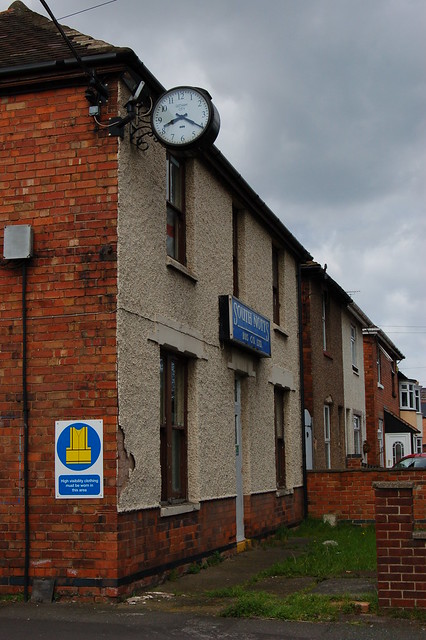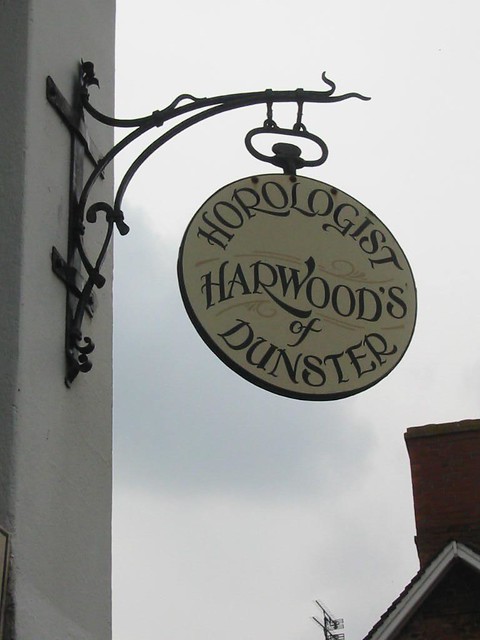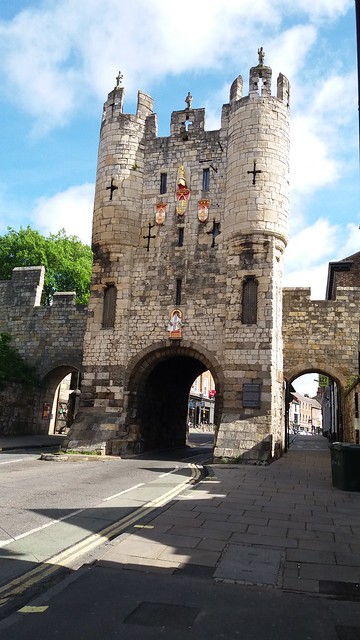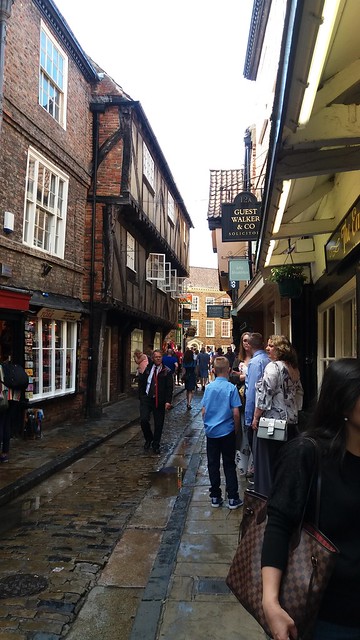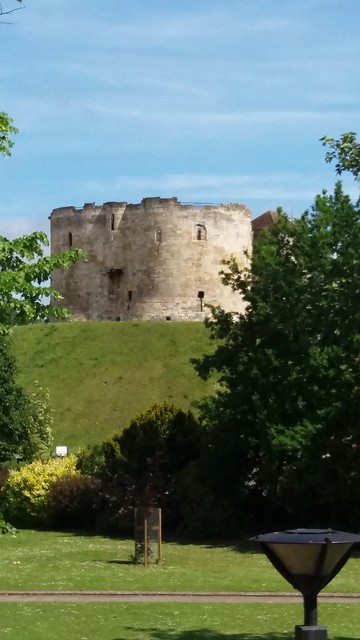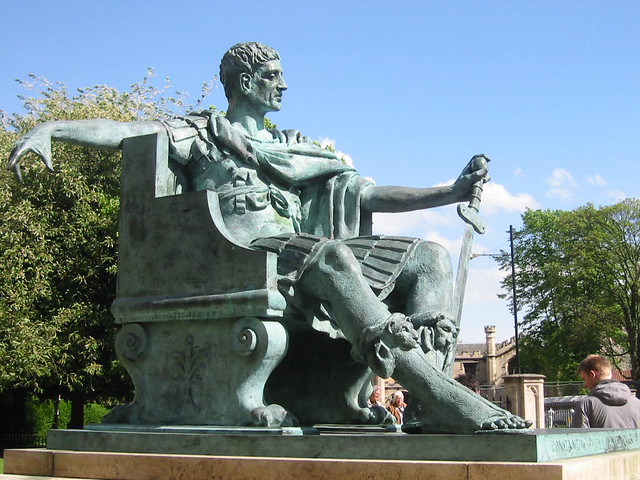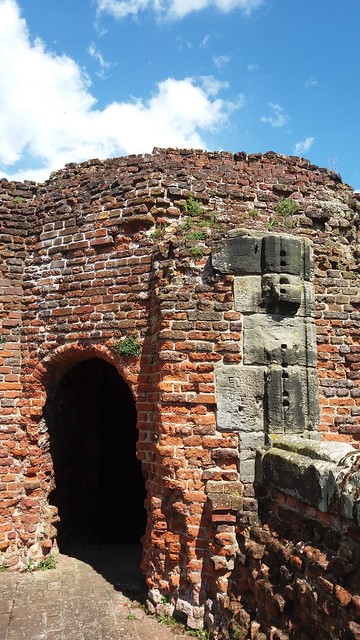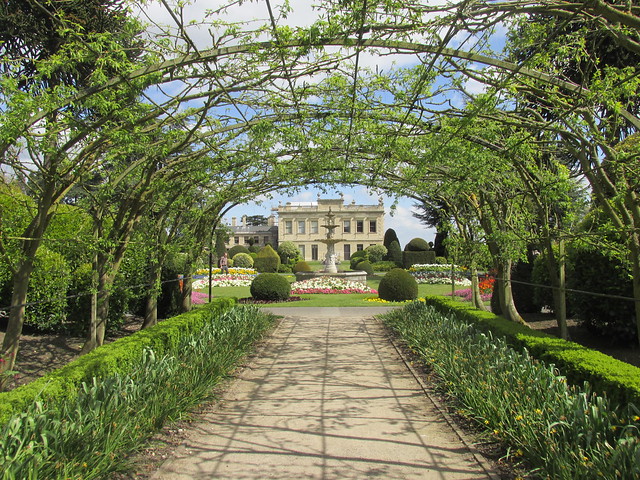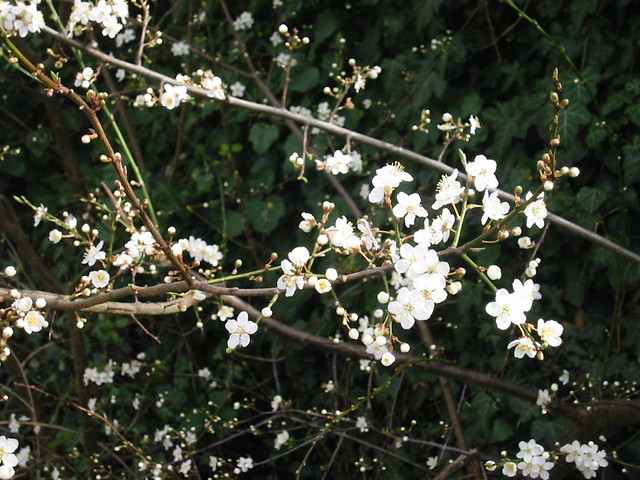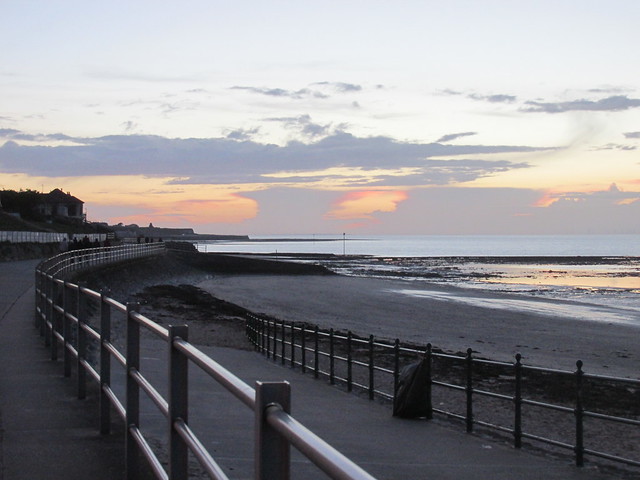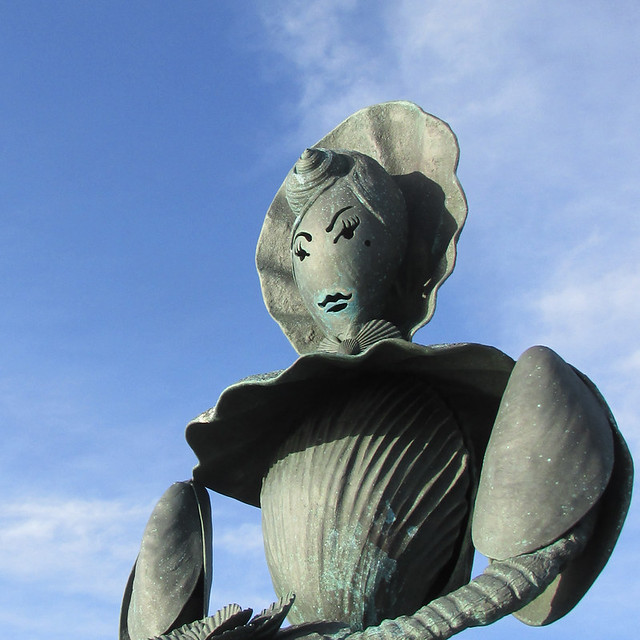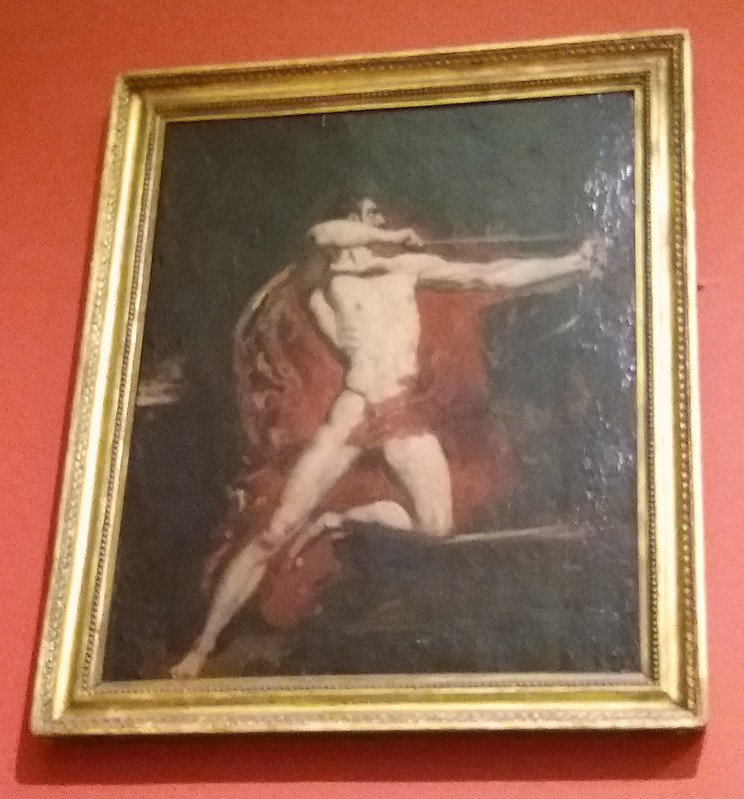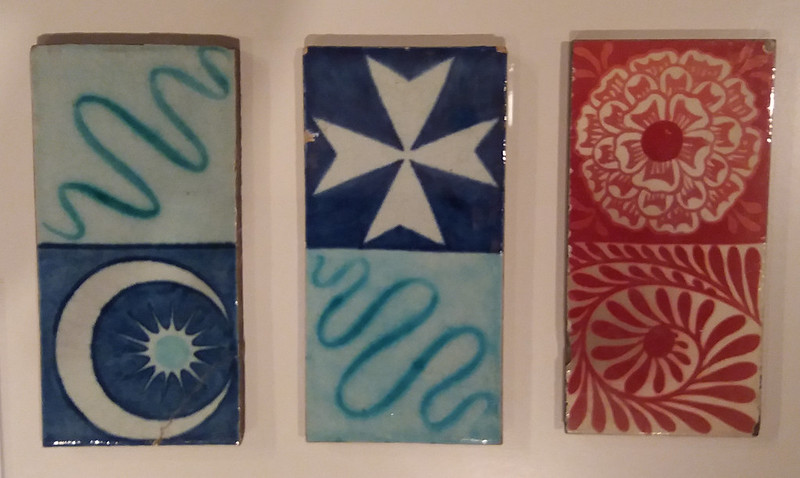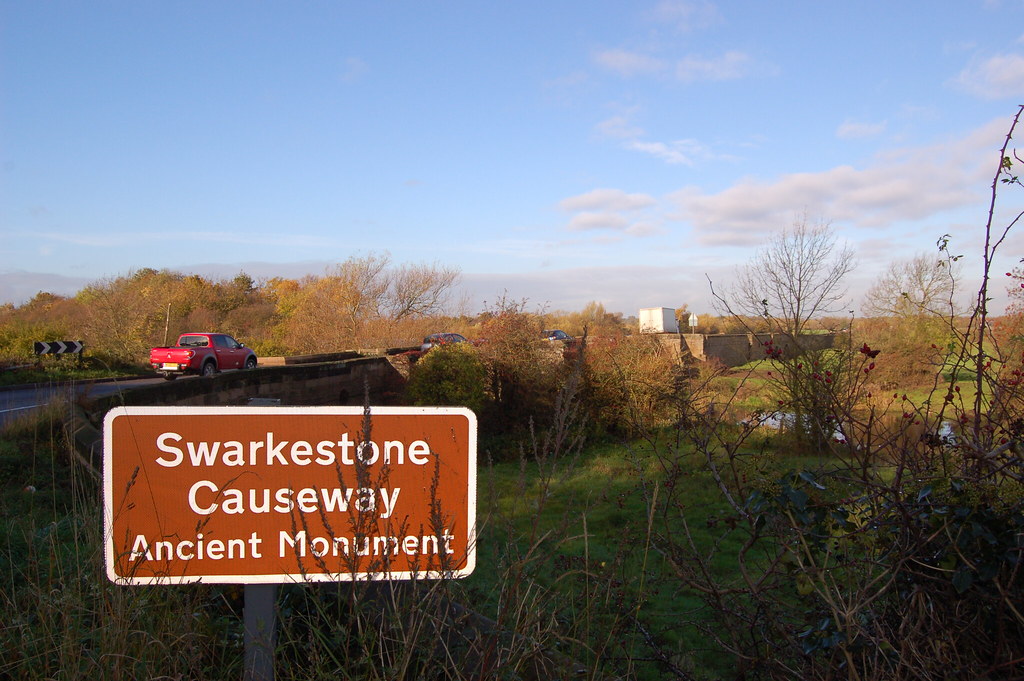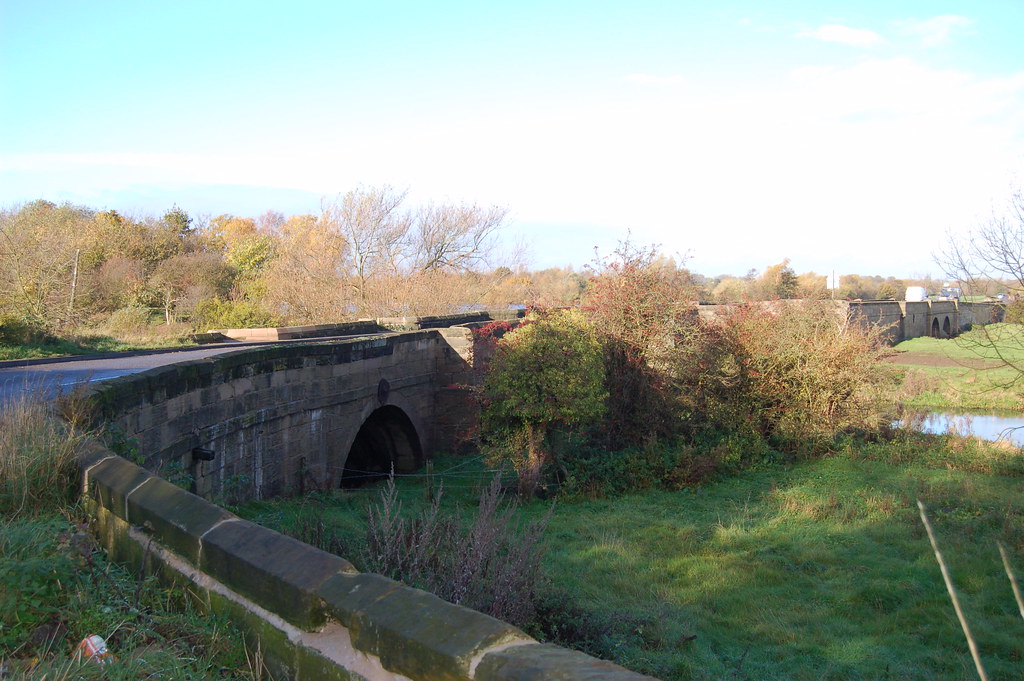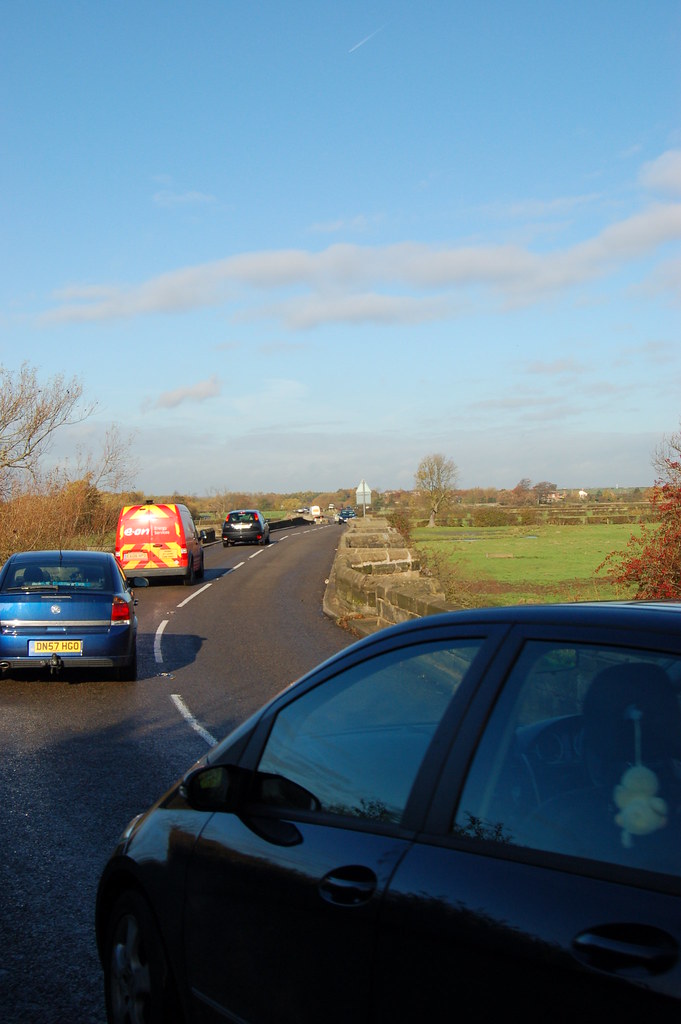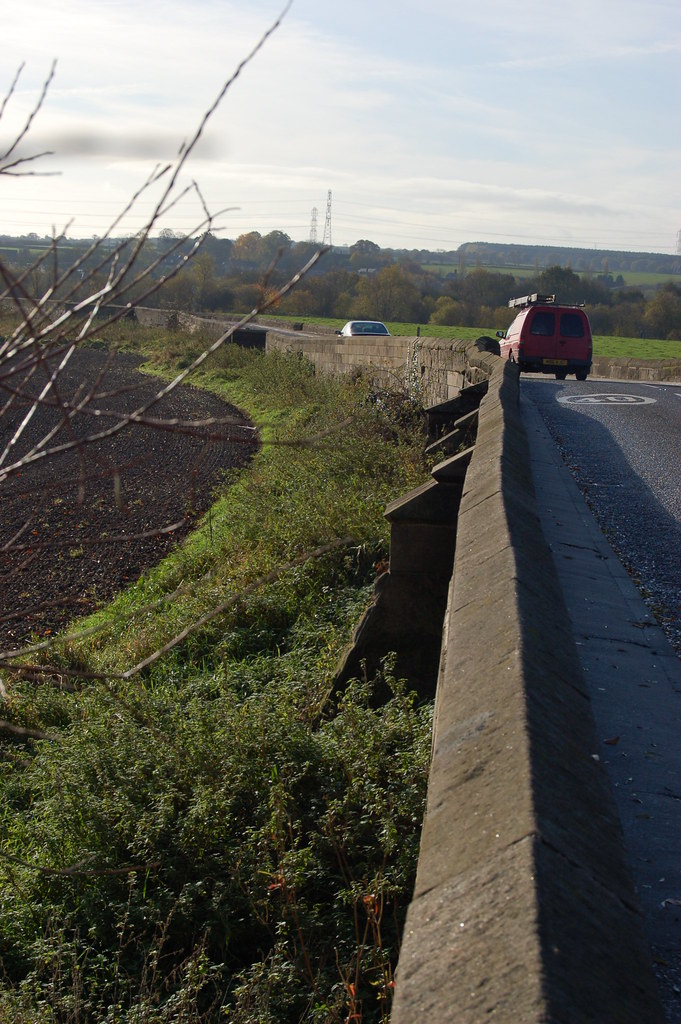Yes, it's a clock. Specifically it's the clock on the top of Scarborough railway station. It's a symbol from my teen years because it stands opposite the old Odeon Cinema (which is now the Stephen Joseph Theatre where Alan Aykbourn plays are always premiered) and many's the evening or afternoon that I've stood looking at this clock while waiting to meet a date. (You get to know it particularly well on the occasions that said date doesn't turn up. How much longer do I leave it before I accept that I've been stood up?)
Scarborough station opened on Monday 7 July 1845, following the completion of the line from York. The station clock was added in about 1884, and was built by Potts of Leeds costing £110, or around £10,000 at today's prices. The whole building is Grade II listed. Interestingly (and something I didn't know until I began my research) it has the longest station bench in the world, at a staggering 95 yards long.
It was needed to accommodate the hundreds of tourists who flocked to the town to drink the spa waters and enjoy the sea air.
You might have seen this wonderful thing before if you read my blogs regularly. It's clearly labelled with its date and purpose. What's a range you ask? It's the thing you cook fish and chips in, and this was the clock that I used to stare at while waiting for my "six penn'orth of chips and scraps" at my local chippy.
The old range didn't meet modern catering hygiene standards and was replaced by a shining stainless steel construction a few years back. I can still remember the beautiful green and off-white sunray back plate in wonderful art deco style. I'm pleased to say that they kept the clock.
Except it isn't a clock, it's a timepiece. What's the difference? A clock chimes. It has a bell. Indeed the word clock derives from various old Germanic, Celtic and French words for bell - like clocca and glocken.
Here's one for my transatlantic friends. It is, of course, the clock in the heart of Grand Central Station in New York. Grand Central is a rapid transit railroad station and you can find it at 42nd and Park. They use the word 'iconic' a lot these days but this thing truly is. Wikipedia says: "The four-faced brass clock on top of the information booth was designed by Henry Edward Bedford (1860–1932) and cast in Waterbury, Connecticut. Each of the four clock faces is made from opalescent glass, though urban legend has it that the faces are made of opal and that Sotheby's and Christie's have estimated their value to be between $10 million and $20 million."
You'll need to look very closely at this one even to spot the clock, let alone see why it's important. It's in the Nottinghamshire village of Gotham (pronounced Goat-um. Sorry to disappoint you.) and it's on the side of the bus depot. Look really closely though......
Yes - it does say Gotham City and that is the bat symbol above the six!
Which brings us to five.
This one is self-explanatory. A horologist is a clock maker and repairer. Literally 'one who studies the hours'. I've always loved this sign. It's in the gorgeous Somerset village of Dunster and it's just so perfect for the shop. A huge pocket-watch hanging over the door.
So there you are. Now the clocks are saying it's time for you to travel over to Tricky's FAST Blog to see other Fives this Friday.
Some chat about historical things. Some of it is inspired by topics on the associated History Anorak blog.
June 09, 2017
June 02, 2017
Five from York
Yorkshire's a funny county. They do things slightly differently there. For example, they eat fruit cake with cheese. (Try it before you sneer!) And where everyone else calls the biggest church in an area a cathedral, York (and other Yorkshire towns) has a Minster. Apparently, according to the Internet, a Minster church is one that was established in Anglo-Saxon times and was attached to a monastery. (But that doesn't explain why Peterborough Cathedral isn't a Minster.) Anyhow, one of the most beautiful sights in York is the Minster. It's a lovely church and really is the heart of Yorkshire - a name they have given to one of the Minster's glorious stained glass windows. Only an outside view, I'm afraid, but you can make out the heart pretty much central to the photo.
Bars and gates
Talking of doing things differently - this is Micklegate Bar. It's one of the ways through the old city walls. (Incidentally, York has one of the most complete, original medieval city walls in the UK.) You might think it's called Micklegate because it's a gate, right? Well it isn't. Gate means street. Bar means gate. And mickle means small. So this is Little Street Gate.
The Shambles
The Shambles is one of York's best known streets. It has lots of claims to fame: Europe's most visited street; Europe's best preserved Medieval street; and most recently, the inspiration for Diagon Alley in the Harry Potter films. In fact you can hear lots of different languages as you walk along the narrow way: you don't understand a word until someone says "Diagon Alley", then continues talking in whatever native tongue they're using.
The word Shambles originates from the Medieval word shamel, which meant booth or bench. The street was the home of the butchers of York and the road has deep channels at each side where water could be sluiced through to wash away the blood and waste.
The street is so narrow, and the buildings overhang so far, that it's possible to shake hands across the road from the upper storeys.
Clifford's Tower
Clifford’s Tower is one of York's best known landmarks. It is part of the old York Castle, once the centre of government for the north of England. It's a motte and bailey structure: the motte being the steep mound and the bailey being the flat area around the mound. Originally there was an 11th-century timber tower on top but it was burned down in 1190, when York’s Jewish community, some 150 strong, was besieged by a mob and forced to seek refuge inside. They committed mass suicide. The present limestone tower dates from the 13th century and was surrounded by a moat
The views from the top are stunning, although tourists don't care about walking in front of you while you're trying to capture it on video. And they seem to ignore the 'one way system' signs on the narrow, spiral staircases. Ho hum.
Romans
Lastly we're going back in time and forward at the same time. York was, of course, established by the Romans, who called it Eboracum. There are still remnants of the old Roman town. Stonegate, for example, has the original Roman street below it and anyone having to dig up the road soon finds Roman masonry. There's a Roman pillar stands opposite the Minster, marking the site of the basilica. It was found during repair excavations at the Minster in 1969 and erected nearby. Between the pillar and the Minster is one of my favourite public sculptures in the whole country. It's Constantine the Great by Philip Jackson; a life size bronze of the Emperor sitting in an elaborate chair and holding a broken sword. Constantine was declared emperor in York in the year 306.
OK so now you have to go and visit the wonderful Tricky over at FAST blog to see what other fives people have collected this week.
OK so now you have to go and visit the wonderful Tricky over at FAST blog to see what other fives people have collected this week.
May 26, 2017
Kirby Muxloe
William, Lord Hastings was a favourite of King Edward IV who made a small fortune during the Wars of the Roses and decided to spend it on a very impressive new house at Kirby Muxloe in Leicestershire. The village was the site of an existing manor house belonging to his family, who also owned nearby Ashby de la Zouch Castle.
Unfortunately William's fortunes changed when Richard, Duke of Gloucester - later Richard III - seized the throne and took a dislike to him. Richard had William's head chopped off, and work on the wonderful house stopped, with just one tower completed, in 1483.
 |
| Just one complete tower |
However, what remains of the castle shows what a magnificent structure it was going to be. Built in the wonderful new material - brick - which was the height of fashion and very expensive at that time. The never finished gatehouse is probably the most impressive part still remaining. It has ornate brick work and dark patterns built in to the rich red courses that symbolise William in happier times.
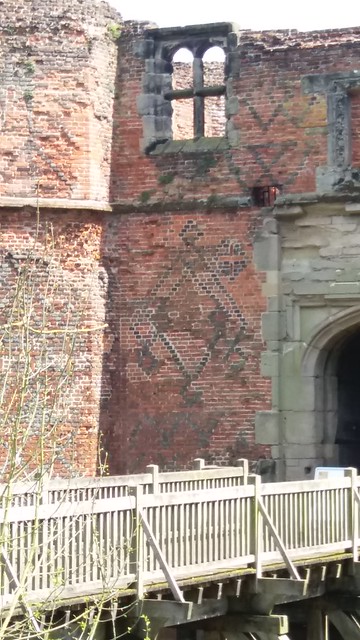 |
| Decorated in darker brick |
A few technical terms: course means a horizontal row of bricks; diaper work is a pattern of bricks in a different colour from the main body, particularly in the form of a criss-cross design; bricks have short ends - headers - and long ends - stretchers; bond is the way in which headers and stretchers are mixed to create the overall pattern. Flemish bond has alternate headers and stretchers in a course, English bond has alternate courses of headers and stretchers. (More about bricks here)
 |
| Magnificent spiral stairs |
Kirby Muxloe is surrounded by a moat, and there were gun ports built into the gateway. There's no evidence that these were ever planned to be defensive structures, however. They might just have been for show, as a display of William's position and power.
Now off you go over to Tricky's FAST Blog to see other Fives this Friday!
May 19, 2017
Five little challenges
A couple of weeks ago we visited Brodsworth Hall and I shared the garden with you. At the time I promised a return to take a look at the inside. It's a fascinating place and I can't possibly do it justice in a single post, so I thought I'd approach it from a different angle. Let's take a look at the challenges of looking after a house of such an age and in such a dilapidated state. You'll be surprised how much it has in common with your own housekeeping - and how much is different.
Brodsworth has a unique way of pointing out the problems it faces in conserving the furniture and fabrics. Rather than making you squirm with tales of nastiness they have introduced wonderful, fluffy toy models of the pests living around the house. Like this "woolly bear", for example,which represents the larva of the carpet moth. As you can see from the photo within the photo - the real thing isn't quite so cute!
Let's face it, nobody enjoys dusting but leaving it in place in a historic house is not an option. Dust is not an innocuous substance that can be easily swept away with the wipe of a cloth. In fact, if it's been in place long enough its chemical properties change and it starts to stick. Meanwhile, those chemical changes can affect the object the dust lies on, damaging the surface. Cleaning is a careful process, because rough handling can cause more damage than the dust! You can see some of the tools they use in the photo.
Most of us, particularly those in older homes, have at some point suffered the arrival of the small, grey intruder Mus domesticus - the house mouse. They cause two sorts of damage - basically one from each end. Firstly, they gnaw. They'll eat their way through anything that poses a barrier for them. Their sharp teeth will go through most things and nothing is really safe. This includes cables, so there's an increased risk of fire. The other end, of course, produces some disgusting stuff. Did you know, for example, that mice pee constantly? It's partly so they can tell where they are. When in doubt, follow the smelly trail home. But they also leave nasty little black packages. which aren't just dirty, they're corrosive.
One problem a large house faces is needing a lot of fireplaces. And a lot of fires means a lot of chimneys. But once the house starts to close down the chimneys aren't maintained and fall victim to bird nests.Then, when the nests are abandoned, the pests move in. One such is the golden spider beetle, and once it gets bored with nest material it is partial to wool, with ensuing damage to the house's carpets!
Then there's a problem you might not have expected. You might remember from the previous post that the last resident of the house, Sylvia Grant-Dalton, was fond of pets. You might also remember that we discussed the possible identity of Binkie Pippy, named on a headstone in the pet cemetery. Well, Binkie and Pippy were actually two animals, spaniels, and for a lot of their lives they were never allowed outside. So when English Heritage took over the house and began the programme of conservation they found a lot of 'evidence' of the dogs' presence. Dog urine is acidic, and there were many holes in curtains and carpets as well as extensive staining.
So, on that fragrant note, I suggest you drop by Tricky's FAST blog to see what more pleasant topics people have found this week!
Brodsworth has a unique way of pointing out the problems it faces in conserving the furniture and fabrics. Rather than making you squirm with tales of nastiness they have introduced wonderful, fluffy toy models of the pests living around the house. Like this "woolly bear", for example,which represents the larva of the carpet moth. As you can see from the photo within the photo - the real thing isn't quite so cute!
Let's face it, nobody enjoys dusting but leaving it in place in a historic house is not an option. Dust is not an innocuous substance that can be easily swept away with the wipe of a cloth. In fact, if it's been in place long enough its chemical properties change and it starts to stick. Meanwhile, those chemical changes can affect the object the dust lies on, damaging the surface. Cleaning is a careful process, because rough handling can cause more damage than the dust! You can see some of the tools they use in the photo.
Most of us, particularly those in older homes, have at some point suffered the arrival of the small, grey intruder Mus domesticus - the house mouse. They cause two sorts of damage - basically one from each end. Firstly, they gnaw. They'll eat their way through anything that poses a barrier for them. Their sharp teeth will go through most things and nothing is really safe. This includes cables, so there's an increased risk of fire. The other end, of course, produces some disgusting stuff. Did you know, for example, that mice pee constantly? It's partly so they can tell where they are. When in doubt, follow the smelly trail home. But they also leave nasty little black packages. which aren't just dirty, they're corrosive.
One problem a large house faces is needing a lot of fireplaces. And a lot of fires means a lot of chimneys. But once the house starts to close down the chimneys aren't maintained and fall victim to bird nests.Then, when the nests are abandoned, the pests move in. One such is the golden spider beetle, and once it gets bored with nest material it is partial to wool, with ensuing damage to the house's carpets!
Then there's a problem you might not have expected. You might remember from the previous post that the last resident of the house, Sylvia Grant-Dalton, was fond of pets. You might also remember that we discussed the possible identity of Binkie Pippy, named on a headstone in the pet cemetery. Well, Binkie and Pippy were actually two animals, spaniels, and for a lot of their lives they were never allowed outside. So when English Heritage took over the house and began the programme of conservation they found a lot of 'evidence' of the dogs' presence. Dog urine is acidic, and there were many holes in curtains and carpets as well as extensive staining.
So, on that fragrant note, I suggest you drop by Tricky's FAST blog to see what more pleasant topics people have found this week!
May 12, 2017
Five things: the Cinque Ports
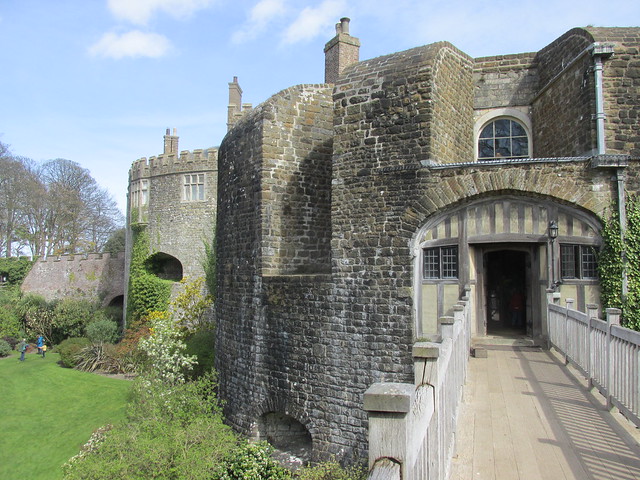 |
| Entrance to Walmer Castle |
There is a group of old towns on the south east coast of Britain called the Cinque Ports. The name is Norman French and means "five ports" because that's how many of them there originally were. Hastings, New Romney, Hythe, Dover and Sandwich. New Romney, however, was damaged by storms and its harbour silted up, so its place was taken by Rye, which was already associated with the group in a way described below.
The five initially joined forces to create a military and trade association to defend the area against potential threats from the English Channel but the arrangement is now completely ceremonial.
The first team must have been proud of the name because they never changed it, in spite of enrolling lots of other towns to support them. Rye (mentioned above) and Winchelsea, were designated "Antient Towns" and the many other places were deemed to be 'limbs' of the original five. At its height the Cinque Ports alliance included 42 towns and villages - but quarante-deux ports doesn't have the same ring to it.
Among them were Bekesbourne, Bulverhythe, Eastbourne, Bexhill-on-Sea, Pevensey, Reculver, Sarre, Walmer, Ramsgate, Brightlingsea, Birchington, St John's (part of Margate), Margate, Folkestone, Ringwould, Woodchurch, Kingsdown and West Hythe. (This is not an exhaustive list!)
Incidentally, it's pronounced "sink ports" not "sank" like proper French would be. But then, Happisburgh in Norfolk is pronounced "Hazebruh" so what does the south east coast know?
In 1155 the Cinque Ports received a Royal Charter to maintain ships ready for the Crown in case of need. The towns were expected to provide 57 ships for 15 days service each, but in exchange residents were exempt from a number of taxes and had various rights - one of which was the right to break into someone's property in order to build sea defences! They were also allowed to keep some of the salvage from shipwrecks. Such privileges made the area a haven for smugglers because the revenue men stayed out of their way.
Over the years flood, high tides, the French and other marauding forces changed the coast in many ways. Erosion and geological movement mean that Sandwich, for example, is now three miles inland. Hastings harbour was sacked by the French in the 13th century and the town no longer acts as a port. (Though it's a lovely fishing town, but they haul the boats up onto the beach.)
In keeping with their current ceremonial status the Cinque Ports today have an official leader called the Lord Warden. The title has often been held by Prime Ministers or other big wigs. Pitt the Younger was Lord Warden in the 18th century and around 20 years later the role went to Arthur Wellesley, Duke of Wellington. Winston Churchill was appointed, as was The Queen Mother. The current holder is Admiral of the Fleet Michael, Baron Boyce. One thing they all have in common is that the post gives them the right to live in Walmer Castle - though these days they tend to have a ceremonial annual week, rather than permanent residence.
Like lots of things in this fair country, the Cinque Ports are a remnant of an older time that are now completely irrelevant, but they impress younger countries who can’t trace their traditions back 200 years, let alone nearly 1,000. They’re pointless. But we can’t quite bear to get rid of them.
Now go over to Tricky's FAST blog to see more Fives on Friday.
April 28, 2017
Brodsworth
 |
| Brodsworth Hall - note the scaffolding |
In opposition to how most heritage organisation behave, EH decided to consolidate it 'as found' rather than restoring it. Today it's in the middle of a massive project to make it safe and suitable for visitors. It's wrapped in scaffolding and largely sheathed in plastic.
The gardens, however, are magnificent. Glorious sunshine gave me the chance to wander round and see them in their full wonder. Here's some photos:
View to the hall across the fountain garden from under the laburnum arch. I'm determined to go back and see it when it's in flower. End of May should do it.
Round the back of the hall is a sweet little pet cemetery with carved headstones for the various animals. One says simply 'Polly parrot' while others give hints such as 'good boy', so I'm assuming that was a dog. There are no clues as to the species of Binkie Pippy, however. Sounds like a bunny to me!
The grounds are scattered with statuary and ghostly white figures in various degrees of dress stand around looking classical. I kind of liked this young lady feeding the pigeons.
And then there was the real wildlife. You get a hint of the colour from the fountain garden in this shot so the delightful robin isn't easy to spot, but he sat there singing his heart out for a while and seemed happy to have his photo taken.
Now off you go over to Tricky's FAST blog to see the other Five on Friday posts. Happy weekend all.
April 21, 2017
Tanner or Barker
 |
| Samples of leather |
1 Leather production
There are lots of processes required in the production of leather and each one has resulted in surnames to identify the jobs. Such as:
Skinner - who skins the beasts
Tanner - who tans leather
Barker - another word for tanner
Currier - a leather dresser
2 Boots and shoes
Footwear is probably one of the commonest uses for leather, even today. It's given rise to a few names too.
Boot - one who made boots
Chaucer - a shoe maker: from the French word chaussure, meaning shoe
3 Other leather goods
And there are lots of other leather goods that all had their own specialist skills. For example:
Glover - who made gloves
Gant or Gaunt - another name for a glover, from the French gant
Bracegirdle - a belt maker
Purser - who made purses
Badger - a bag maker (and nothing to do with black and white animals at all!)
4 Saddlery
Making saddles and associated horse harness and tack was a very skilled job with lots of different styles for racing, hunting, and even side-saddles for the ladies.
Sadler - obviously one who made saddles
Burrell - less obviously a saddler, from the French bourrelier
Sellers - also from the French, sellier, or saddler
5 Associated metalwork
And to hold all the leather harness bits together you need lots of specially shaped metalwork, collectively known as lorinery. Walsall had plenty of associated lorinery factories that supplied the leather workers. Their skills also gave us some associated surnames.
Lorimer - a maker or dealer in lorinery
Buckler - made buckles
Sperrin - made spurs
And there you have it. Lots of hidden information in your name! Now go across to Tricky's FAST blog to see other fives this Friday.
April 14, 2017
Shell Grotto
As promised last week we're paying another visit to Margate Shell Grotto. Here are five photos of the mysterious structure.
There are a number of shell-decorated follies and grottoes in the UK but, unlike the majority, the grotto in Margate was created using native species - mainly mussels, cockles, whelks, limpets, scallops and oysters. Only four shells among the 4.6 million are exotic: two Caribbean queen conches and two Pacific giant clams.
This is just one of the weird things about the 104 feet long tunnel in Grotto Hill. The grotto takes the form of a winding passage that splits into two, forming a circle, then ending with a square space called the altar room. At the point where the path splits the ceiling rises to a dome with a gap at the top that allows some natural light to enter.
The shells form a series of panels along the walls, each with complicated designs incorporating symbols and pictograms that have been interpreted in several ways. Some people see little but attractive patterns, others have identified astrological signs, representations of ancient gods, phallic designs, and other mystical themes.
According to local legend the grotto was discovered in 1835 when local landowner James Newlove decided to dig a duck pond. His son Joshua found a strange hole in the ground and James lowered him through it to see what lay beneath. The boy reported seeing pictures and a cave. Estimates of its age vary from several thousand years, to Victorian folly.
Other ideas have included the suggestion that the site was prehistoric; it might have been a Templar Chapel; or Newlove built the tunnels himself. Whatever the truth, the grotto became a tourist attraction within a couple of years, earning Newlove a considerable income.
It's been open to the public ever since, and it recently underwent a programme of restoration to prevent water damage. A new project was launched in 2012 to replace missing 'roundels'. Some parts of the patterns were created by fixing them to circles of slate, which have since fallen away. Those slates are now being repaired.
Now drop by Tricky's FAST blog to see other Five on Friday posts.
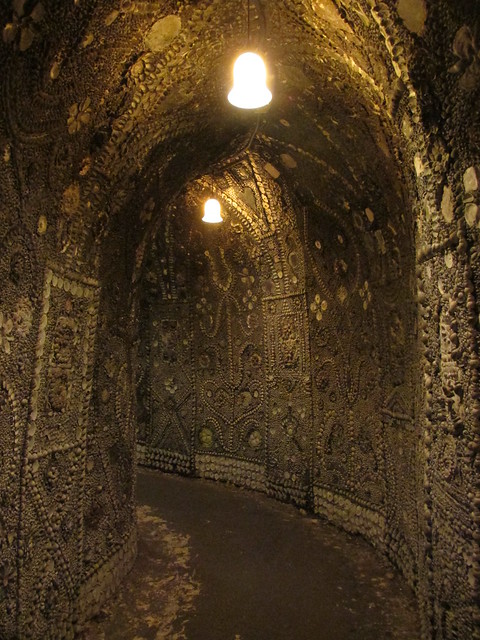 |
| A view down the tunnel |
This is just one of the weird things about the 104 feet long tunnel in Grotto Hill. The grotto takes the form of a winding passage that splits into two, forming a circle, then ending with a square space called the altar room. At the point where the path splits the ceiling rises to a dome with a gap at the top that allows some natural light to enter.
 |
| Looking up into the dome |
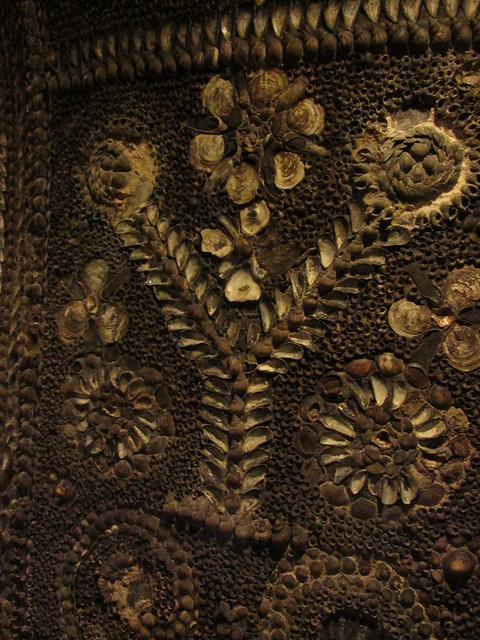 |
| Detail from the Aries panel |
According to local legend the grotto was discovered in 1835 when local landowner James Newlove decided to dig a duck pond. His son Joshua found a strange hole in the ground and James lowered him through it to see what lay beneath. The boy reported seeing pictures and a cave. Estimates of its age vary from several thousand years, to Victorian folly.
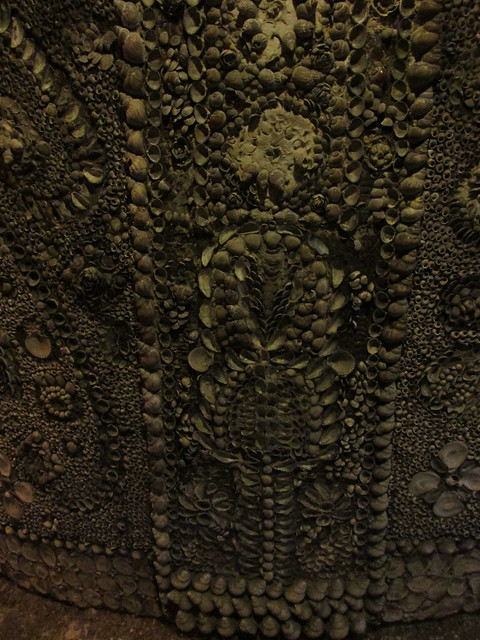 |
| Part of the 'skeleton' panel |
Other ideas have included the suggestion that the site was prehistoric; it might have been a Templar Chapel; or Newlove built the tunnels himself. Whatever the truth, the grotto became a tourist attraction within a couple of years, earning Newlove a considerable income.
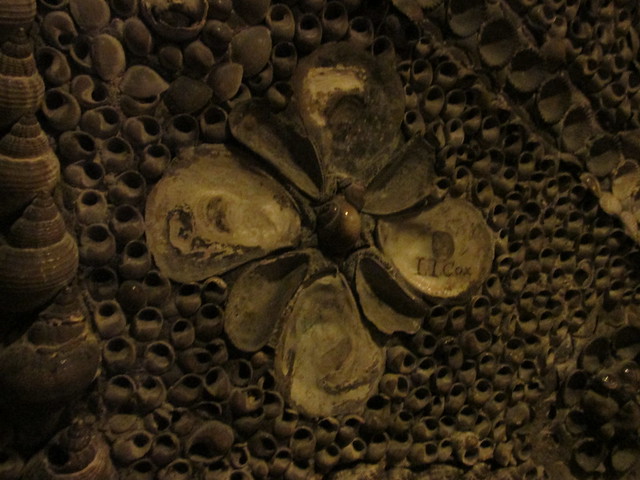 |
| Detail of a pattern - with old graffiti! |
It's been open to the public ever since, and it recently underwent a programme of restoration to prevent water damage. A new project was launched in 2012 to replace missing 'roundels'. Some parts of the patterns were created by fixing them to circles of slate, which have since fallen away. Those slates are now being repaired.
Now drop by Tricky's FAST blog to see other Five on Friday posts.
April 10, 2017
April
It's April, and the month began with such beautiful weather that I couldn't help but remember Robert Browning's poem Home Thoughts from Abroad:
O, to be in England
Now that April 's there,
And whoever wakes in England
Sees, some morning, unaware,
That the lowest boughs and the brushwood sheaf
Round the elm-tree bole are in tiny leaf,
While the chaffinch sings on the orchard bough
In England—now!
Our recent trip south also reminded me of something my Dad used to say - that the seasons march up and down the country at approximate walking speed. The apple trees of the Kent orchards were all in beautiful blossom whereas here in the Midlands the buds had yet to break. On our return our local trees are catching up.
Of course, April's also the month in which the cuckoo is known to arrive and traditionally across England there used to be Cuckoo Fairs to mark the season change and the arrival of Spring. Many involved releasing a cuckoo from a basket, though in Marsden in West Yorkshire they used to build a fence around a cuckoo's nest to try to make it stay longer.
April 07, 2017
Margate 5
Sorry for a very brief Five this week. We've been away for my birthday. Where? Margate. (It's in Kent.) So here's five things from there.
The RNLI is the charity that saves lives at sea. Hundreds of men and women up and down the country risk their lives regularly in rough and hazardous seas to go to the help of others. There's a rescue boat near the harbour arm in Margate.
This clock is on the tower of the tourist information office, known as the Droit House, a building which used to act as the customs house and also the place where ships paid fees to enter the harbour.
The artist JMW Turner said Margate had the finest skies in all of Europe. And I have to admit they've been pretty good this week.
Turner was a bit of a rogue and in later life lived in Margate with a Mrs Booth - seaside landlady. While there he was known as Mr Booth, even though he had a wife and children back home in London. There's a sculpture on the harbour arm that's called Mrs Booth, and it's shaped like a souvenir shell lady - except it's MUCH bigger.
And finally - hidden in a back street away from the town centre is a mysterious cave. 104 feet long and decorated with 4.6 million shells. No-one knows who made it, when or why, but it was discovered in the 1830s and opened as a tourist attraction very shortly after. It deserves a post of its own - so watch out for more about it later.
This has been a very bitty Five on Friday post. Now head over to Tricky's FAST blog to see others that have been put together with much more care than mine!
The RNLI is the charity that saves lives at sea. Hundreds of men and women up and down the country risk their lives regularly in rough and hazardous seas to go to the help of others. There's a rescue boat near the harbour arm in Margate.
This clock is on the tower of the tourist information office, known as the Droit House, a building which used to act as the customs house and also the place where ships paid fees to enter the harbour.
The artist JMW Turner said Margate had the finest skies in all of Europe. And I have to admit they've been pretty good this week.
Turner was a bit of a rogue and in later life lived in Margate with a Mrs Booth - seaside landlady. While there he was known as Mr Booth, even though he had a wife and children back home in London. There's a sculpture on the harbour arm that's called Mrs Booth, and it's shaped like a souvenir shell lady - except it's MUCH bigger.
And finally - hidden in a back street away from the town centre is a mysterious cave. 104 feet long and decorated with 4.6 million shells. No-one knows who made it, when or why, but it was discovered in the 1830s and opened as a tourist attraction very shortly after. It deserves a post of its own - so watch out for more about it later.
This has been a very bitty Five on Friday post. Now head over to Tricky's FAST blog to see others that have been put together with much more care than mine!
March 31, 2017
Leicester Five
A few weeks ago I had to visit Leicester for a meeting and on my way back to my car I passed the city art gallery in New Walk. I had a spare 20 minutes so I nipped in for a quick look. Here's a selection of what I found. Sorry about the quality of the photos - I took them with my phone.
The Bowman, oil on board, painted about 1825-30. It's by William Etty, (1787 - 1849) who was known for his landscapes featuring nudes. There's a larger version of this in York City Art Gallery, that shows more of the landscape, but still doesn't identify what he's aiming at. Etty was born in York and the gallery has a number of Etty's paintings.
The Sluggard by Frederick, Lord Leighton. Bronze, cast in 1890. Leighton (1830-1896) was a painter and sculptor who became president of the Royal Academy in 1878. This bronze was a small version of a life-sized work that now stands in Tate Britain.
Head of an Arab, oil on canvas, painted 1857. Believed to be a preparatory work, designed to perfect the head before including it in a larger work. Also by Lord Leighton.
Vulcan - no, it's nothing to do with Mr Spock - a bronze by Tiziano Aspetti (1565 - 1607). Aspetti worked mainly in his native Padua, and Venice. The small figure shows the Roman god of blacksmithing, fire and volcanoes, hence his powerful build and strong arms.
And for something different, I found a small exhibition of works by the artist William De Morgan (1839 - 1917), a lifelong friend of designer William Morris. These hand-painted, ceramic tiles are believed to have been designed as part of a commission for P&O Ships for interior decor.
Now off you go to Tricky's FAST blog to see what other Five on Friday posts there are.
The Bowman, oil on board, painted about 1825-30. It's by William Etty, (1787 - 1849) who was known for his landscapes featuring nudes. There's a larger version of this in York City Art Gallery, that shows more of the landscape, but still doesn't identify what he's aiming at. Etty was born in York and the gallery has a number of Etty's paintings.
The Sluggard by Frederick, Lord Leighton. Bronze, cast in 1890. Leighton (1830-1896) was a painter and sculptor who became president of the Royal Academy in 1878. This bronze was a small version of a life-sized work that now stands in Tate Britain.
Head of an Arab, oil on canvas, painted 1857. Believed to be a preparatory work, designed to perfect the head before including it in a larger work. Also by Lord Leighton.
Vulcan - no, it's nothing to do with Mr Spock - a bronze by Tiziano Aspetti (1565 - 1607). Aspetti worked mainly in his native Padua, and Venice. The small figure shows the Roman god of blacksmithing, fire and volcanoes, hence his powerful build and strong arms.
And for something different, I found a small exhibition of works by the artist William De Morgan (1839 - 1917), a lifelong friend of designer William Morris. These hand-painted, ceramic tiles are believed to have been designed as part of a commission for P&O Ships for interior decor.
Now off you go to Tricky's FAST blog to see what other Five on Friday posts there are.
March 24, 2017
Swarkestone Bridge
This week is the first time of hosting Five on Friday by Tricky at FAST blog. So to welcome him and start things well, here's five views of a rather impressive structure close to where I live. Sorry about the photos. It's not the easier thing to capture on film. (Don't forget to visit Tricky's blog to see what other people have written.)
The Grade I listed Swarkestone Bridge and Causeway, at almost a mile in length, is the longest stone bridge in England. At one time a bridge chapel and toll house stood on the causeway but there is little sign of them now. The structure crosses the River Trent flood plain between Swarkestone and Stanton-by-Bridge and is still a significant crossing for travellers passing from Derby to Melbourne.
It carries a bus route and it's quite creative driving when you meet one coming the other way. As you can see, it's narrow, and the photo shows one of the wider bits!
Built in the 13th century, the causeway is reputed to be the work of two local sisters whose lovers drowned while trying to cross the flood plain in high water. The horrified sisters saw the men swept away by the river and vowed that no-one else would suffer the same fate. They spent the rest of their lives building and maintaining the causeway and bridge and so were penniless when they died.
The Grade I listed Swarkestone Bridge and Causeway, at almost a mile in length, is the longest stone bridge in England. At one time a bridge chapel and toll house stood on the causeway but there is little sign of them now. The structure crosses the River Trent flood plain between Swarkestone and Stanton-by-Bridge and is still a significant crossing for travellers passing from Derby to Melbourne.
It carries a bus route and it's quite creative driving when you meet one coming the other way. As you can see, it's narrow, and the photo shows one of the wider bits!
Built in the 13th century, the causeway is reputed to be the work of two local sisters whose lovers drowned while trying to cross the flood plain in high water. The horrified sisters saw the men swept away by the river and vowed that no-one else would suffer the same fate. They spent the rest of their lives building and maintaining the causeway and bridge and so were penniless when they died.
March 17, 2017
More Place Names
 |
| Roman remains in Wall. |
Yes, I know I've done place names before but I've had a particularly hectic week and I'm pushed for time. I wanted to take part in Five on Friday this week because it's the last one to be hosted by Amy at Love Made My home. I wanted to say thank you to her for looking after us for so long and being such a welcoming host. It's been fun, and I've learned lots from my fellow Fivers.
But please bear with me if this is short and sweet. I've chosen five places that have meant something to me for some reason, either that I've lived close to them, or passed through them regularly.
Irthlingborough, Northamptonshire. First recorded in 780 as Yrtlingaburg, which means "fortified manor belonging to the ploughmen" in Old English. The Domesday Book* (1086) called it Erdinburne, These days the locals call it Artleknock. I have no idea why!
Margate, Kent. First recorded as Meregate in 1254. From the Old English meaning "gap leading to the sea". Now known as the original seaside. (Though Northern coastal folk would disagree!)
Meriden, West Midlands. First mentioned in 1230. It means "pleasant valley" or "where merrymaking takes place" in Old English. In spite of what some people believe, its nothing to do with 'meridian' and absolutely not related to the fact that the village is as close to the centre of England as makes no difference.
Wall, Staffordshire. Originally listed as Wal in manorial documents from 1166. Want to guess what's there? Correct - it's a wall. In fact it's several walls dating from the Roman era when Letocetum was an important place on Watling Street. The old Roman road still runs through the village but its 'modern' replacement (The A5, brought 'up to date' by Thomas Telford in the 1820s.) runs past the village now.
Wetwang, North Yorkshire
Mentioned in the Domesday Book* (1086). From the Old Scandinavian for "a place for trial of legal actions". We go past this place regularly on the way to see Mr Anorak's mother. We always laugh at the sound of it.
Notes
*The Domesday Book (pronounced 'doomsday') was a record of the settlements in England after its defeat by the Normans in 1066. One of the first things William ordered was an extensive survey of what he now owned, and it was published 20 years later. It's a valuable historic source for researchers.
Much of the information in this post has been gathered from the Oxford Dictionary of English Place Names, (1998 Past Times edition)
Subscribe to:
Posts (Atom)
